Topographic Correction of Landsat TM-5 and Landsat OLI-8 Imagery to Improve the Performance of Forest Classification in the Mountainous Terrain of Northeast Thailand
Abstract
:1. Introduction
2. Study Area and Data Set
2.1. Study Area
2.2. Landsat Imagery
2.3. Digital Elevation Models (DEM)
3. Methodology
3.1. Stratification of Forest and Non-Forest Areas
3.2. Topographic Correction Methods
3.2.1. Improved Cosine Correction
3.2.2. C-Correction
3.2.3. Minnaert Correction
3.2.4. Statistical Empirical Correction (SEC)
3.2.5. Variable Empirical Coefficient Algorithm (VECA)
3.3. Evaluation of Topographic Correction Methods
3.3.1. Visual Interpretation
3.3.2. Statistical Interpretation
3.3.3. Evaluation of Shadow and Non-Shadow Area
3.4. Training and Validation Data
3.5. Forest Classification
Random Forest (RF) Classifier
3.6. Accuracy Assessment
4. Results
4.1. Evaluation of Topographic Correction Methods
4.1.1. Visual Interpretation with SRTM and ASTER GDEM Based Topographic Correction
4.1.2. Statistical Interpretation of SRTM DEM and ASTER GDEM-Based Topographic Corrections
4.2. Performance Evaluation of Topographic Correction Methods in Shadow and Non-Shadow Area
4.3. Evaluation of Topographically Corrected and Uncorrected Forest Classification Accuracies
5. Discussion
5.1. Topographic Correction and DEMs
5.2. Forest Classification Results and Accuracies
6. Conclusions
Acknowledgments
Author Contributions
Conflicts of Interest
References
- Gu, D.; Gillespie, A. Topographic normalization of Landsat TM images of forest based on subpixel Sun-canopy-sensor geometry. Remote Sens. Environ. 1998, 64, 166–175. [Google Scholar] [CrossRef]
- Roy, D.P.; Wulder, M.A.; Loveland, T.R.; Woodcock, C.E.; Allen, R.G.; Anderson, M.C.; Helder, D.; Irons, J.R.; Johnson, D.M.; Kennedy, R.; et al. Landsat-8: Science and product vision for terrestrial global change research. Remote Sens. Environ. 2014, 145, 154–172. [Google Scholar] [CrossRef]
- Stibig, H.J.; Achard, F.; Carboni, S.; Raši, R.; Miettinen, J. Change in tropical forest cover of Southeast Asia from 1990 to 2010. Biogeosciences 2014, 11, 247–258. [Google Scholar] [CrossRef] [Green Version]
- Li, M.; Im, J.; Beier, C. Machine learning approaches for forest classification and change analysis using multi-temporal Landsat TM images over Huntington Wildlife Forest. GISci. Remote Sens. 2013, 50, 361–384. [Google Scholar]
- Szantoi, Z.; Simonetti, D. Fast and robust topographic correction method for medium resolution satellite imagery using a stratified approach. IEEE J. Sel. Top. Appl. Earth Obs. Remote Sens. 2013, 6, 1921–1933. [Google Scholar] [CrossRef]
- Bruce, C.M.; Hilbert, D.W. Pre-processing Methodology for Application to Landsat TM/ETM+ Imagery of the Wettropics; Rainforest CRC: Cairns, Australia, 2004; p. 44. [Google Scholar]
- Bodart, C.; Eva, H.; Beuchle, R.; Raši, R.; Simonetti, D.; Stibig, H.J.; Brink, A.; Lindquist, E.; Achard, F. Pre-processing of a sample of multi-scene and multi-date Landsat imagery used to monitor forest cover changes over the tropics. ISPRS J. Photogramm. Remote Sens. 2011, 66, 555–563. [Google Scholar] [CrossRef]
- Adhikari, H.; Heiskanen, J.; Maeda, E.E.; Pellikka, P.K.E. Does topographic normalization of Landsat images improve fractional tree cover mapping in tropical mountains? ISPRS Int. Arch. Photogramm. Remote Sens. Spat. Inf. Sci. 2015, XL-7/W3, 261–267. [Google Scholar] [CrossRef]
- Shepherd, J.D.; Dymond, J.R. Correcting satellite imagery for the variance of reflectance and illumination with topography. Int. J. Remote Sens. 2003, 24, 3503–3514. [Google Scholar] [CrossRef]
- Riaño, D.; Chuvieco, E.; Salas, J.; Aguado, I. Assessment of different topographic corrections in Landsat-TM data for mapping vegetation types. IEEE Trans. Geosci. Remote Sens. 2003, 41, 1056–1061. [Google Scholar]
- Dorren, L.K.; Maier, A.B.; Seijmonsbergen, A.C. Improved Landsat-based forest mapping in steep mountains terrain using object based classification. Forest Ecol. Manag. 2003, 183, 31–46. [Google Scholar] [CrossRef]
- Hale, S.R.; Rock, B.N. Impact of topographic normalization on land-cover classification accuracy. Photogramm. Eng. Remote Sens. 2003, 69, 785–791. [Google Scholar] [CrossRef]
- Huang, H.; Gongac, P.; Clintonc, N.; Huia, F. Reduction of atmospheric and topographic effect on Landsat TM data for forest classification. Int. J. Remote Sens. 2007, 29, 5623–5642. [Google Scholar] [CrossRef]
- Tan, B.; Masek, J.G.; Wolfe, R.; Gao, F.; Huang, C.; Vermote, E.F.; Sexton, J.O.; Ederer, G. Improved forest change detection with terrain illumination corrected Landsat images. Remote Sens. Environ. 2013, 136, 469–483. [Google Scholar] [CrossRef]
- Ke, L.; Tuong, T.; Van Hung, N. Correction of spectral radiance of optical satellite image for mountainous terrain for studying land surface cover changes. Geod. Cartogr. 2014, 63, 39–53. [Google Scholar] [CrossRef]
- Cuo, L.; Vogler, J.B.; Fox, J.M. Topographic normalization for improving vegetation classification in a mountainous watershed in northern Thailand. Int. J. Remote Sens. 2010, 31, 3037–3050. [Google Scholar] [CrossRef]
- Vanonckelen, S.; Lhermitte, S.; Rompaey, A.V. The effect of atmospheric and topographic corrections on pixel-based image composites: Improved forest cover detection in mountain environments. Int. J. Appl. Earth Obs. Geoinf. 2015, 35, 320–328. [Google Scholar] [CrossRef]
- Tokola, T.; Sarkeala, J.; Van Der Linden, M. Use of topographic correction in Landsat TM-based forest interpretation in Nepal. Int. J. Remote Sens. 2001, 22, 551–563. [Google Scholar] [CrossRef]
- Teillet, P.M.; Guindon, B.; Goodenough, D.G. On the slope-aspect correction of multispectral scanner data. Can. J. Remote Sens. 1982, 8, 84–106. [Google Scholar] [CrossRef]
- Meyer, P.; Itten, K.I.; Kellenberger, T.; Sandmeier, S.; Sandmeier, R. Radiometric corrections of topographically induced effects on Landsat TM data in an alpine environment. ISPRS J. Photogram. Remote Sens. 1993, 48, 17–28. [Google Scholar] [CrossRef]
- Wu, Q.; Jin, Y.; Fan, H. Evaluating and comparing performances of topographic correction methods based on multi-source DEMs and Landsat-8 OLI Data. Int. J. Remote Sens. 2016, 37, 4712–4730. [Google Scholar] [CrossRef]
- Civco, D.L. Topographic normalization of landsat thematic mapper digital imagery. Photogram. Eng. Remote Sens. 1989, 55, 1303–1309. [Google Scholar]
- Zakšek, K.; Čotar, K.; Veljanovski, T.; Pehani, P.; Oštir, K. Topographic correction module at storm (TC@Storm). ISPRS Int. Arch. Photogramm. Remote Sens. Spat. Inf. Sci. 2015, XL-7/W3, 721–728. [Google Scholar] [CrossRef]
- Lu, D.; Ge, H.; He, S.; Xu, A.; Zhou, G.; Du, H. Pixel-based Minnaert correction method for reducing topographic effects on a Landsat 7 ETM+ image. Photogramm. Eng. Remote Sens. 2008, 74, 1343–1350. [Google Scholar]
- Moreira, E.P.; Valeriano, M.M. Application and evaluation of topographic correction methods to improve land cover mapping using object-based classification. Int. J. Appl. Earth Obs. Geoinf. 2014, 32, 208–217. [Google Scholar] [CrossRef]
- Hantson, S.; Chuvieco, E. Evaluation of different topographic correction methods for Landsat imagery. Int. J. Appl. Earth Obs. Geoinf. 2011, 13, 691–700. [Google Scholar] [CrossRef]
- Kobayashi, S.; Sanga-Ngoie, K. The integrated radiometric correction of optical remote sensing imageries. Int. J. Remote Sens. 2008, 29, 5957–5985. [Google Scholar] [CrossRef]
- Richter, R.; Kellenberger, T.; Kaufmann, H. Comparison of topographic correction methods. Remote Sens. 2009, 1, 184–196. [Google Scholar] [CrossRef] [Green Version]
- Sola, I.; González-Audícana, M.; Álvarez-Mozos, J. The added value of stratified topographic correction of multispectral images. Remote Sens. 2016, 8, 131. [Google Scholar] [CrossRef]
- Gao, Y.; Zhang, W. Variable empirical coefficient algorithm for removal of topographic effects on remotely sensed data from rugged terrain. Int. Geosci. Remote Sens. Symp. 2007, 1, 4733–4736. [Google Scholar]
- Gao, Y.; Zhang, W. A simple empirical topographic correction method for ETM+ imagery. Int. J. Remote Sens. 2009, 30, 2259–2275. [Google Scholar] [CrossRef]
- Vanonckelen, S.; Lhermitte, S.; Van Rompaey, A. The effect of atmospheric and topographic correction methods on land cover classification accuracy. Int. J. Appl. Earth Obs. Geoinf. 2013, 24, 9–21. [Google Scholar] [CrossRef]
- Vanonckelen, S.; Lhermitte, S. Performance of atmospheric and topographic correction methods on Landsat imagery in mountain areas. Int. J. Remote Sens. 2014, 35, 4952–4972. [Google Scholar] [CrossRef]
- Blesius, L.; Weirich, F. The use of the Minnaert correction for land-cover classification in mountainous terrain. Int. J. Remote Sens. 2005, 26, 3831–3851. [Google Scholar] [CrossRef]
- Gitas, I.Z.; Devereux, B.J. The role of topographic correction in mapping recently burned Mediterranean forest areas from Landsat TM images. Int. J. Remote Sens. 2006, 27, 41–54. [Google Scholar] [CrossRef]
- Soenen, S.A.; Peddle, D.R.; Coburn, C.A.; Hall, R.J.; Hall, F.G. Improved topographic correction of forest image data using a 3-D canopy reflectance model in multiple forward mode. Int. J. Remote Sens. 2008, 29, 1007–1027. [Google Scholar] [CrossRef]
- She, X.; Zhang, L.; Cen, Y.; Wu, T.; Huang, C.; Baig, M.H.A. Comparison of the continuity of vegetation indices derived from Landsat 8 OLI and Landsat 7 ETM+ data among different vegetation types. Remote Sens. 2015, 7, 13485–13506. [Google Scholar] [CrossRef]
- Thai National Parks. Available online: https://www.thainationalparks.com/khao-yai-national-park (accessed on 19 October 2015).
- Khao Yai National Park. Available online: https://en.wikipedia.org/wiki/Khao_Yai_National_Park (accessed on 19 October 2015).
- The Land Processes Distributed Active Archive Center. Available online: https://lpdaac.usgs.gov/data_access/glovis (accessed on 10 February 2016).
- The Shuttle Radar Topographic Mission (SRTM). Available online: https://lta.cr.usgs.gov/SRTM (accessed on 30 July 2016).
- Advanced Spaceborne Thermal Emission and Reflection Radiometer (ASTER) Global Digital Elevation Model (GDEM). Available online: http://earthexplorer.usgs.gov/ (accessed on 10 February 2016).
- McDonald, E.R.; Wu, X.; Caccetta, P.A.; Campbell, N.A. Illumination correction of Landsat TM data in South East NSW. In Proceedings of the Tenth Australasian Remote Sensing Conference, Adelaide, Australia, 21–25 August 2000.
- Machala, M. Forest mapping through object-based image analysis of multispectral and LiDAR aerial data. Eur. J. Remote Sens. 2014, 47, 117–131. [Google Scholar] [CrossRef]
- Goslee, S.C. Analyzing remote sensing data in R: The Landsat Package. J. Stat. Softw. 2011, 43, 1–25. [Google Scholar] [CrossRef]
- Smith, J.A.; Lin, T.L.; Ranson, K.J. The Lambertian assumption and Landsat data. Photogram. Eng. Remote Sens. 1980, 46, 1183–1189. [Google Scholar]
- Ediriweera, S.; Pathirana, S.; Danaher, T.; Nichols, D.; Moffiet, T. Evaluation of different topographic corrections for Landsat TM data by Prediction of Foliage Projective Cover (FPC) in topographically complex landscapes. Remote Sens. 2013, 5, 6767–6789. [Google Scholar] [CrossRef]
- Wulder, M.A.; Franklin, S.E. Remote Sensing of Forest Environments: Concepts and Case Studies; Springer: New York, NY, USA, 2003; p. 200. [Google Scholar]
- Karathanassi, V.; Andronis, V.; Rokos, D. Evaluation of the topographic normalization methods for a Mediterranean forest area. Int. Arch. Photogramm. Remote Sens. 2000, 33, 654–661. [Google Scholar]
- Olofsson, P.; Foody, G.M.; Herold, M.; Stehman, S.V.; Woodcock, C.E.; Wulder, M.A. Good practices for estimating area and assessing accuracy of land change. Remote Sens. Environ. 2014, 148, 42–57. [Google Scholar] [CrossRef]
- FAO. Map Accuracy Assessment and Area Estimation Map Accuracy Assessment and Area Estimation: A Practical Guide; FAO: Rome, Italy, 2016; p. 12. [Google Scholar]
- Liang, L.; Chen, Y.; Hawbaker, T.; Zhu, Z.; Gong, P. Mapping mountain Pine beetle mortality through growth trend analysis of time-series Landsat data. Remote Sens. 2014, 6, 5696–5716. [Google Scholar] [CrossRef]
- Breiman, L. Random Forests. Mach. Learn. 2001, 45, 5–32. [Google Scholar] [CrossRef]
- Liaw, A.; Wiener, M. Classification and Regression by randomForest. R News 2002, 2, 18–22. [Google Scholar]
- Immitzer, M.; Vuolo, F.; Atzberger, C. First experience with Sentinel-2 data for crop and tree species classifications in central Europe. Remote Sens. 2016, 8, 166. [Google Scholar] [CrossRef]
- Liu, J.; Heiskanen, J.; Aynekulu, E.; Maeda, E.E.; Pellikka, P.K.E. Land cover characterization in west Sudanian savannas using seasonal features from annual Landsat time series. Remote Sens. 2016, 8, 365. [Google Scholar] [CrossRef]
- Lowe, B.; Kulkarni, A. Multispectral image analysis using random forest. Int. J. Soft Comput. 2015, 6, 1–14. [Google Scholar] [CrossRef]
- Shen, W.; Li, M.; Huang, C.; Wei, A. Quantifying live aboveground biomass and forest disturbance of mountainous natural and plantation forests in Northern Guangdong, China, based on multi-temporal Landsat, PALSAR and field plot data. Remote Sens. 2016, 8, 595. [Google Scholar] [CrossRef]
- R Core Team. R: A Language and Environment for Statistical Computing; R Foundation for Statistical Computing: Vienna, Austria, 2016. [Google Scholar]
- Benjamin Leutner and Ned Horning. RStoolbox: Tools for Remote Sensing Data Analysis. R Package Version 0.1.4. 2016. Available online: https://CRAN.R-project.org/package=RStoolbox (accessed on 19 October 2016).
- QGIS Development Team. QGIS Geographic Information System. Open Source Geospatial Foundation Project. 2016. Available online: http://www.qgis.org/ (accessed on 19 October 2016).
- Foody, G.; Hill, R. Classification of tropical forest classes from Landsat TM data. Int. J. Remote Sens. 1996, 17, 2353–2367. [Google Scholar] [CrossRef]
- Gao, M.L.; Zhao, W.J.; Gong, Z.N.; Gong, H.L.; Chen, Z.; Tang, X.M. Topographic correction of ZY-3 satellite images and its effects on estimation of shrub leaf biomass in mountainous areas. Remote Sens. 2014, 6, 2745–2764. [Google Scholar] [CrossRef]
- Wang, L.; Chen, J.; Zhang, H.; Chen, L. Difference analysis of SRTM C-Band DEM and ASTER GDEM for global land cover mapping. In Proceedings of the 2011 International Symposium on Image and Data Fusion (ISIDF), Tengchong, Yunnan, China, 9–11 August 2011.
- Hirt, C.; Filmer, M.S.; Featherstone, W.E. Comparison and validation of the recent freely available ASTER-GDEM ver1, SRTM ver4.1 and GEODATA DEM-9S ver3 digital elevation models over Australia. Aust. J. Earth Sci. 2010, 57, 337–347. [Google Scholar] [CrossRef]
- Balthazar, V.; Vanacker, V.; Lambin, E.F. Evaluation and parameterization of ATCOR3 topographic correction method for forest cover mapping in mountain areas. Int. J. Appl. Earth Obs. Geoinf. 2012, 18, 436–450. [Google Scholar] [CrossRef]
- Frey, H.; Paul, F. On the suitability of the SRTM DEM and ASTER GDEM for the compilation of: Topographic parameters in glacier inventories. Int. J. Appl. Earth Obs. Geoinf. 2012, 18, 480–490. [Google Scholar] [CrossRef]
- Sandmeier, S.; Itten, K.I. A Physically-based model to correct atmospheric and illumination effects in optical satellite data of rugged terrain. IEEE Trans. Geosci. Remote Sens. 1997, 35, 708–717. [Google Scholar] [CrossRef]
- Kachmar, M.; Sanchez-Azofeifa, G.A.; Rivard, B.; Kakubari, Y. Improved forest cover classification in an industrialized mountain area in Japan. Mt. Res. Dev. 2005, 25, 349–356. [Google Scholar] [CrossRef]
- Santillan, J.R.; Makinano-Santillan, M. Vertical accuracy assessment of 30-M resolution ALOS, ASTER, and SRTM Global DEMS over northeastern Mindanao, Philippines. ISPRS Int. Arch. Photogramm. Remote Sens. Spat. Inf. Sci. 2016, XLI-B4, 149–156. [Google Scholar] [CrossRef]

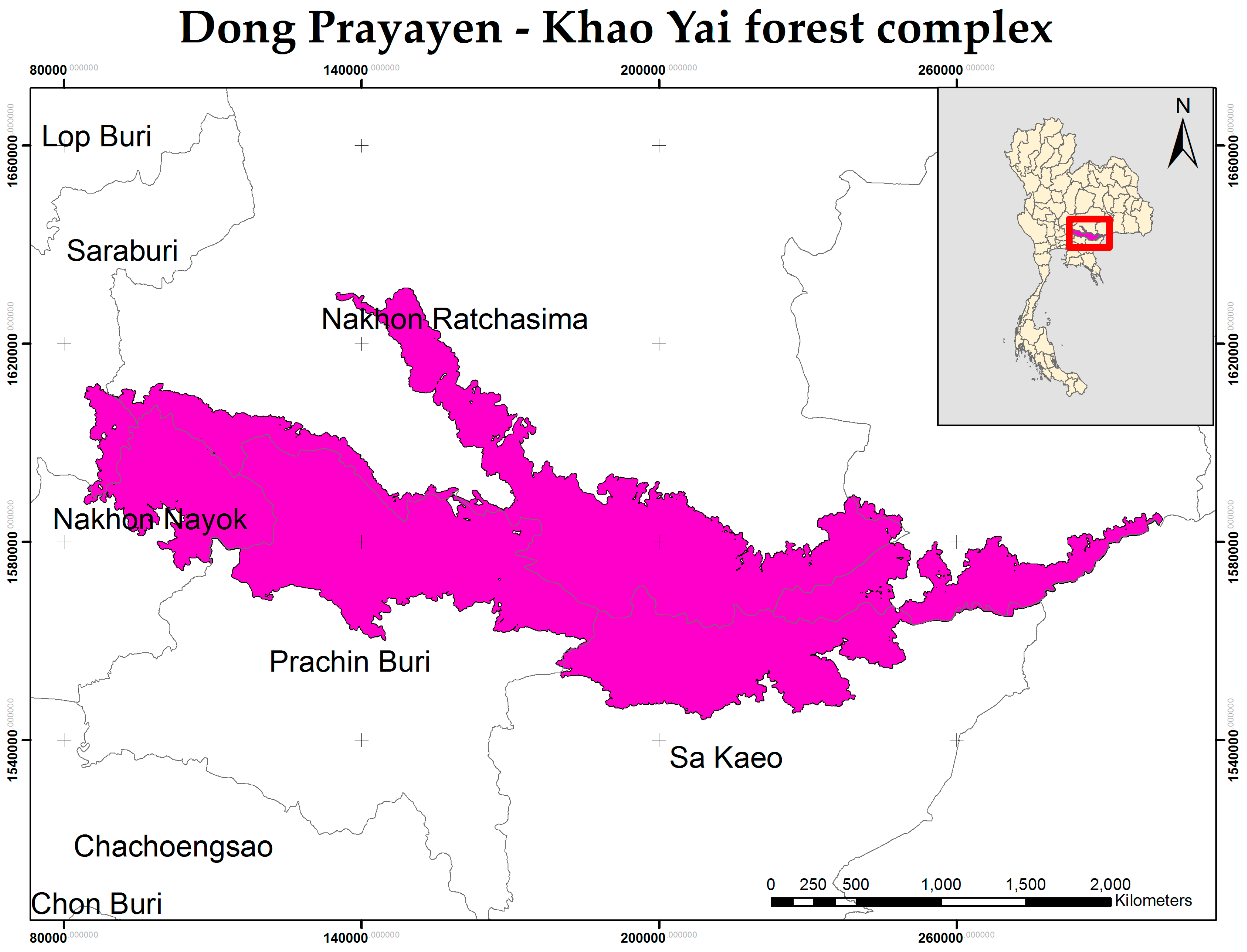
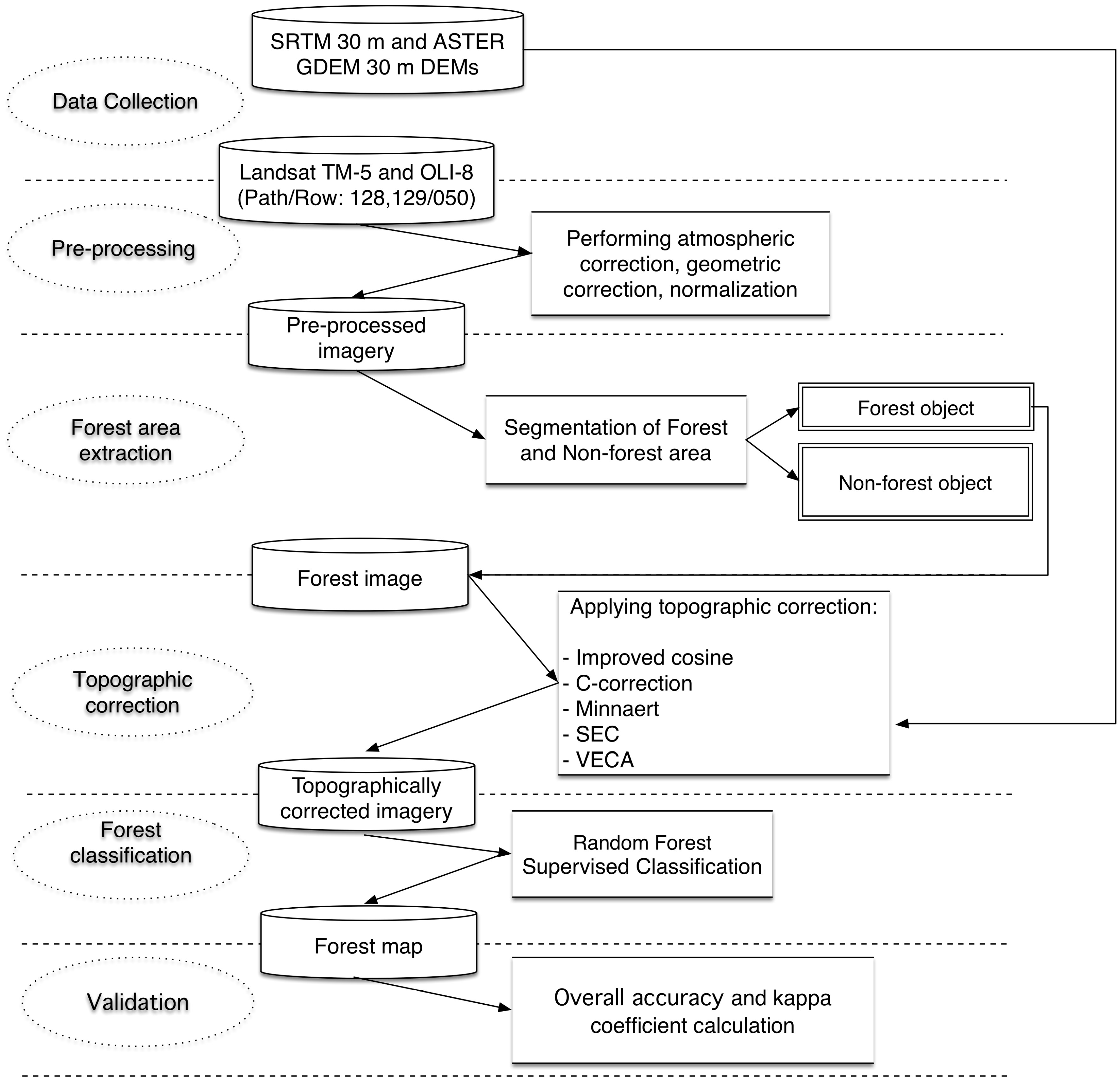
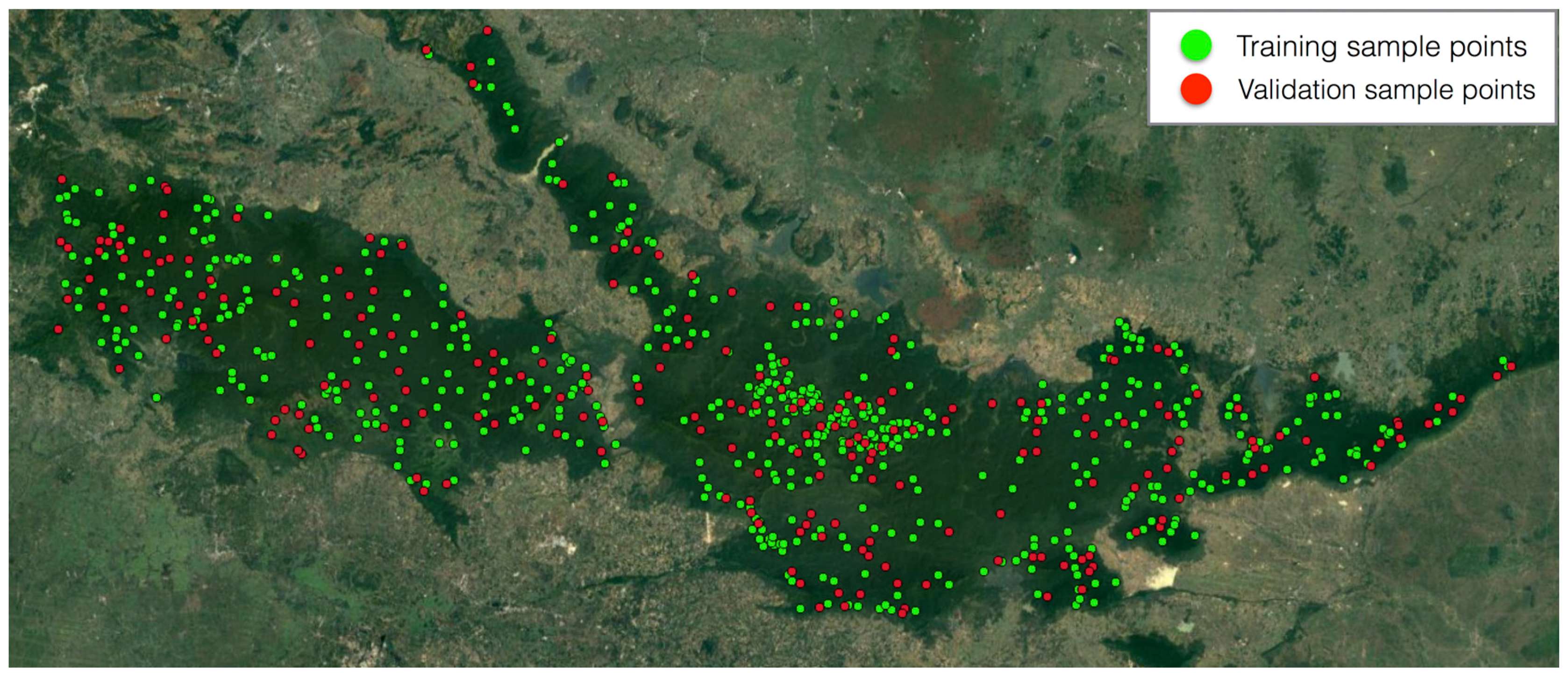
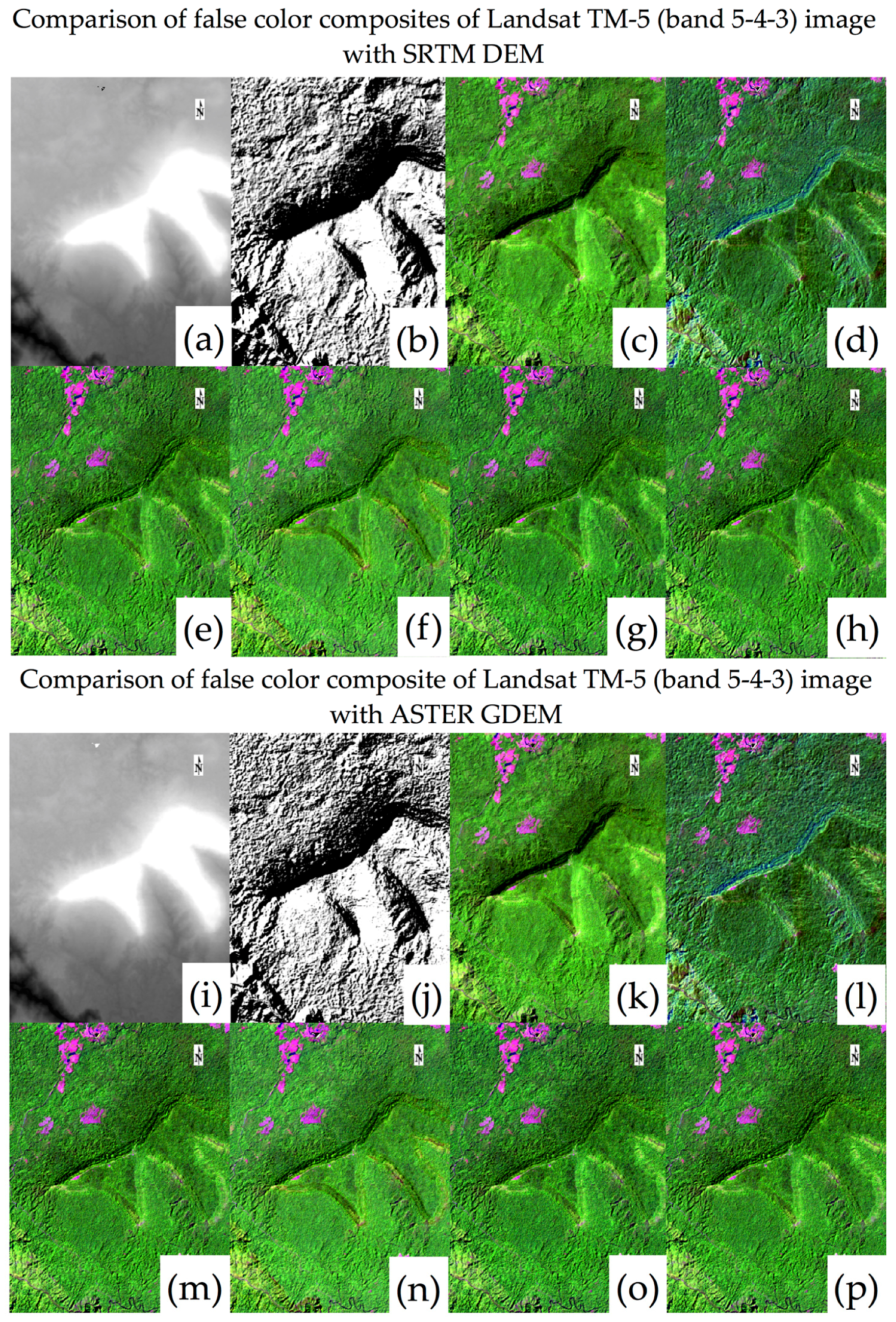
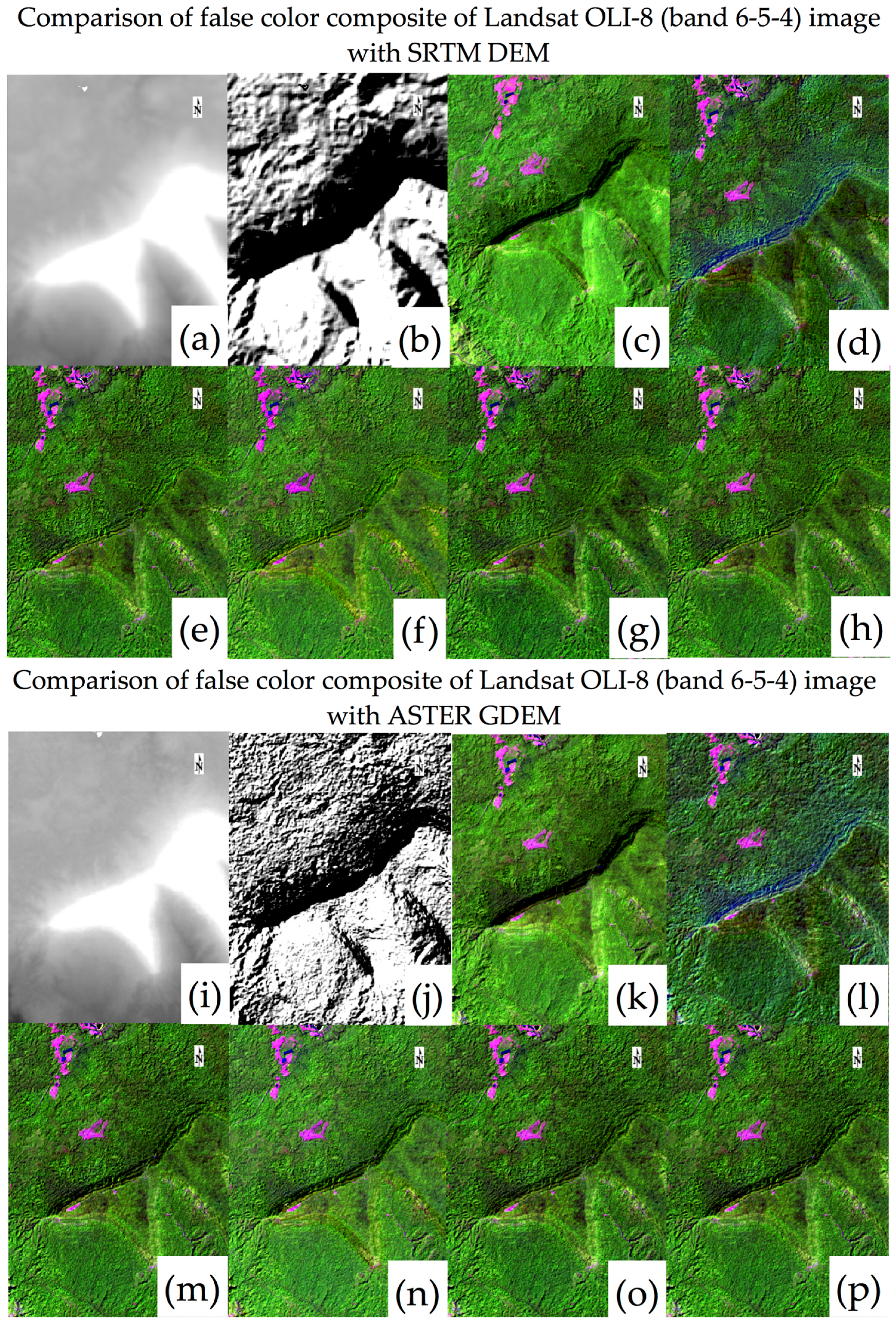
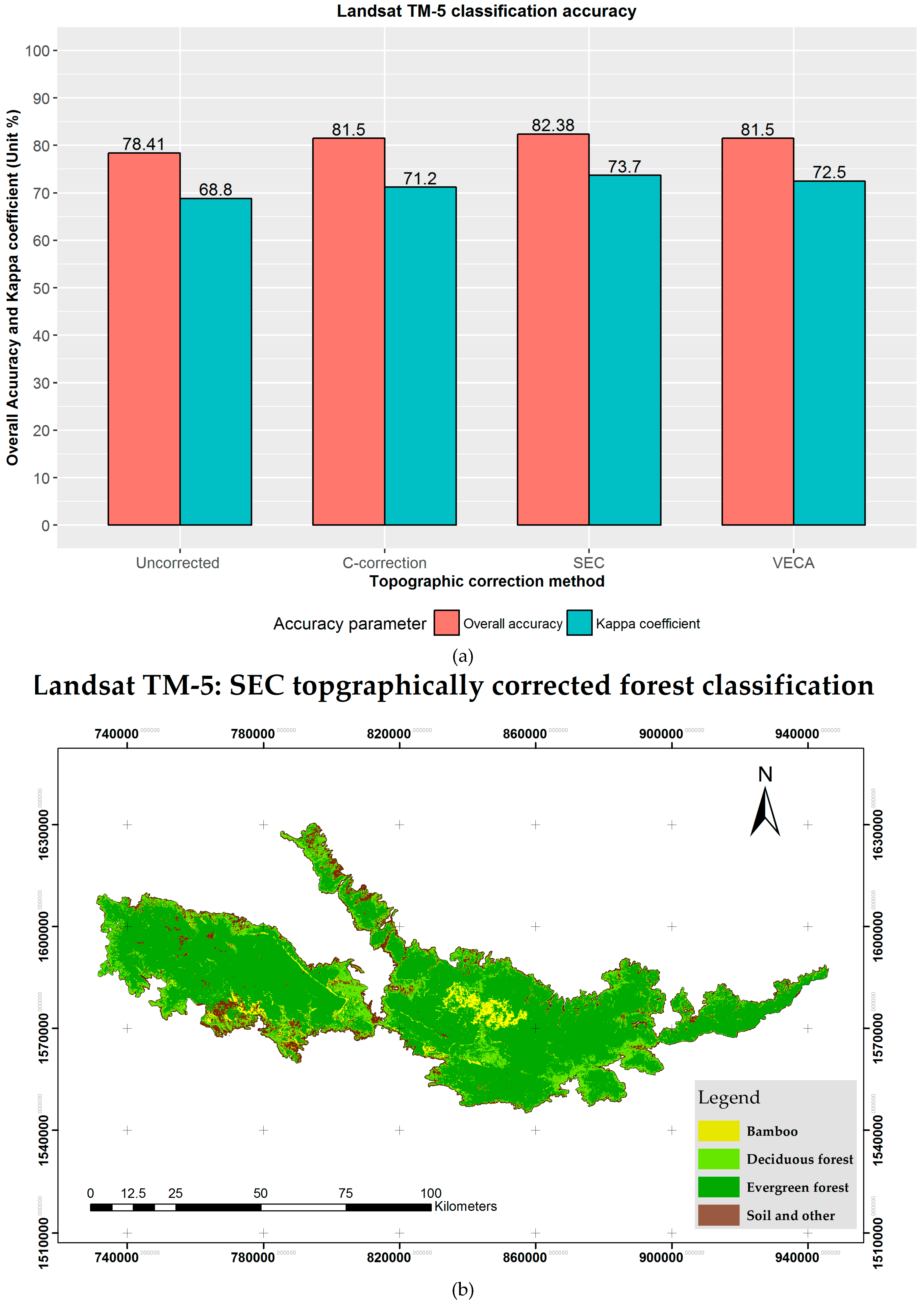
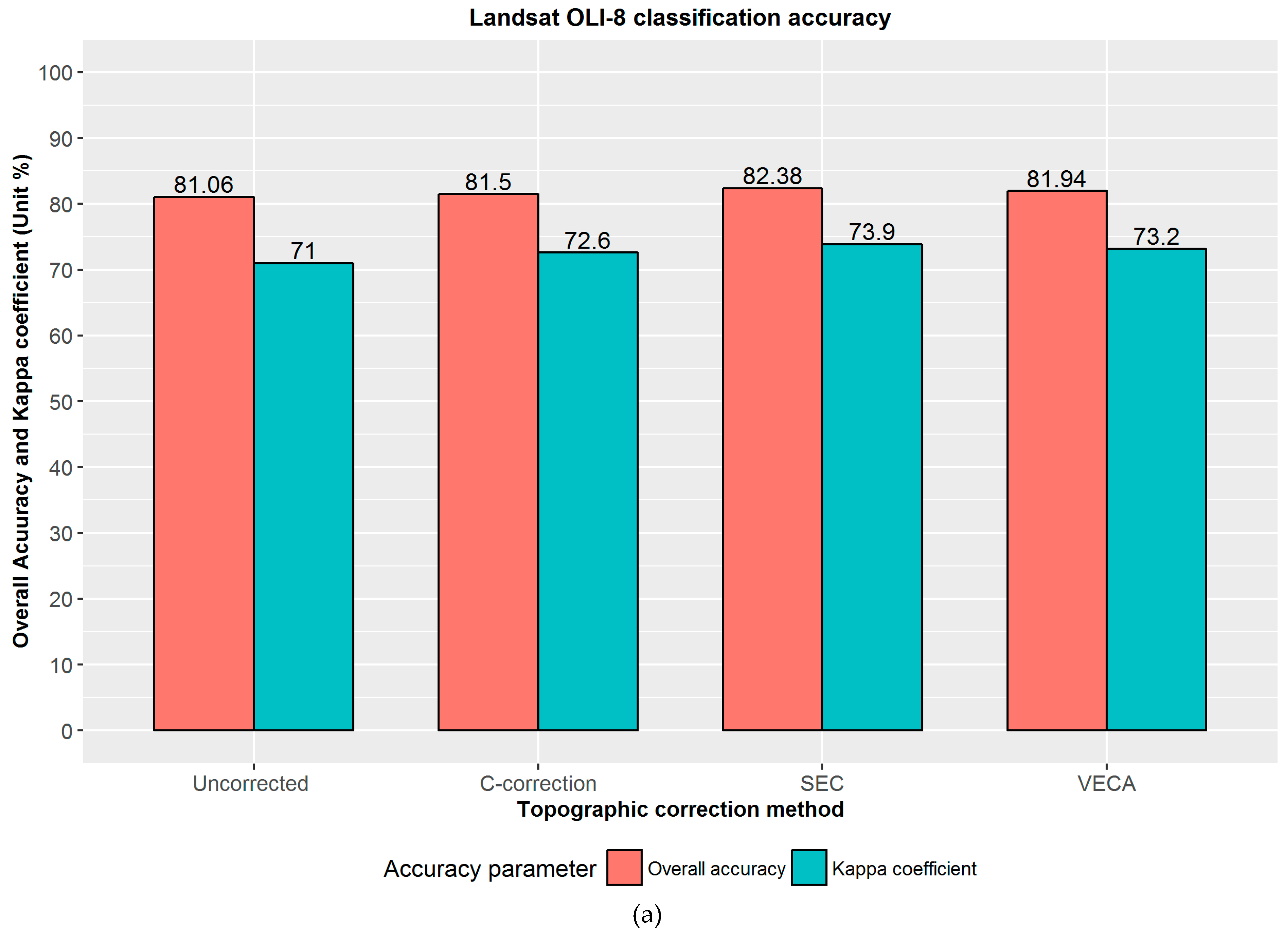
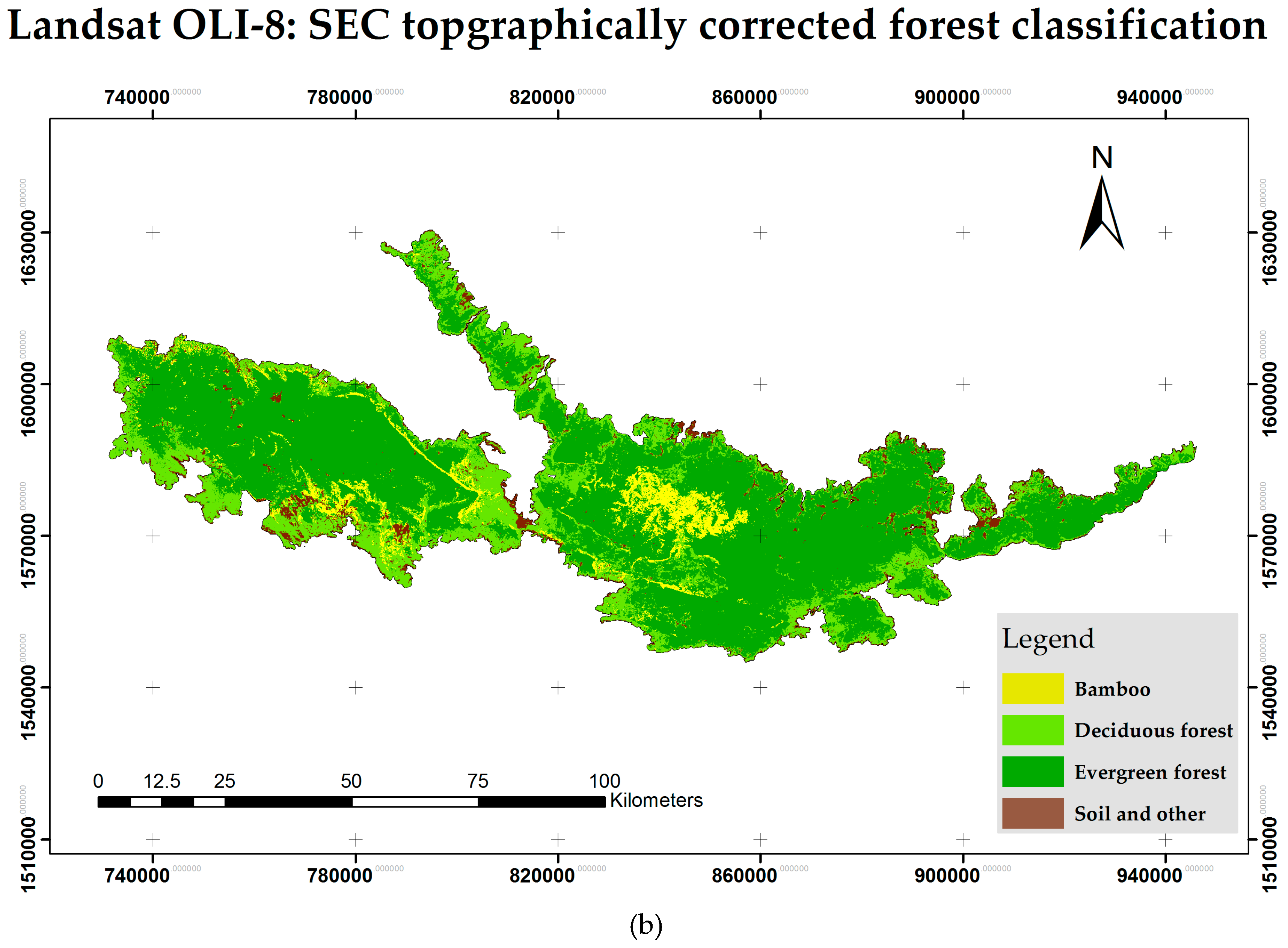
| No | Landsat Sensor (Path/Row) | Date Acquired | Sun Azimuth | Sun Elevation |
|---|---|---|---|---|
| 1 | Landsat TM-5 128/050 | 1999-02-02 | 132.41329646 | 44.42900903 |
| 2 | Landsat TM-5 129/050 | 1999-02-09 | 130. 01909034 | 45.70329359 |
| 3 | Landsat OLI-8 128/050 | 2015-04-19 | 094. 94624942 | 65.59779841 |
| 4 | Landsat OLI-8 129/050 | 2015-02-05 | 136.35602977 | 48.70124627 |
| No. | Correction Method | Equation |
|---|---|---|
| 1 | Improved cosine | |
| 2 | C-correction | |
| 3 | Minnaert | |
| 4 | Statistical-empirical | |
| 5 | VECA |
| (a) Landsat TM-5 Using STRM DEM | ||||||||||||||||||
| Original | Improved Cosine | C-Correction | Minnaert | SEC | VECA | |||||||||||||
| CV | Evergreen Forest | Deciduous Forest | Bamboo Forest | Evergreen Forest | Deciduous Forest | Bamboo Forest | Evergreen Forest | Deciduous Forest | Bamboo Forest | Evergreen Forest | Deciduous Forest | Bamboo Forest | Evergreen Forest | Deciduous Forest | Bamboo Forest | Evergreen Forest | Deciduous Forest | Bamboo Forest |
| Band 1 | 2.85 | 3.55 | 2.10 | 12.91 | 26.87 | 25.93 | 2.59 | 3.23 | 3.92 | 8.73 | 4.31 | 3.66 | 2.50 | 3.23 | 3.61 | 2.59 | 3.23 | 4.05 |
| Band 2 | 7.11 | 8.99 | 5.40 | 11.54 | 24.05 | 23.67 | 5.78 | 7.36 | 4.63 | 9.81 | 7.67 | 4.71 | 5.21 | 7.50 | 4.86 | 5.78 | 7.36 | 4.78 |
| Band 3 | 7.37 | 13.75 | 8.05 | 12.12 | 22.97 | 22.50 | 6.17 | 11.71 | 6.25 | 9.48 | 11.84 | 5.97 | 5.56 | 12.07 | 5.87 | 6.17 | 11.71 | 6.42 |
| Band 4 | 21.18 | 18.98 | 15.34 | 13.43 | 26.15 | 20.76 | 14.02 | 17.77 | 12.37 | 14.94 | 17.28 | 11.80 | 9.95 | 19.07 | 10.91 | 14.02 | 17.77 | 12.35 |
| Band 5 | 26.66 | 34.18 | 26.94 | 17.49 | 26.10 | 18.66 | 18.35 | 26.83 | 18.21 | 19.39 | 27.35 | 17.92 | 11.74 | 28.35 | 16.75 | 18.35 | 26.83 | 18.33 |
| Band 6 | 30.38 | 44.20 | 31.51 | 24.14 | 30.14 | 20.81 | 24.76 | 35.78 | 22.31 | 25.54 | 36.69 | 22.01 | 15.90 | 38.20 | 19.71 | 24.76 | 35.78 | 22.50 |
| Average | 15.93 | 20.61 | 14.89 | 15.27 | 26.05 | 22.06 | 11.94 | 17.11 | 11.28 | 14.65 | 17.52 | 11.01 | 8.48 | 18.07 | 10.28 | 11.94 | 17.11 | 11.40 |
| Difference of average CVs | - | - | - | 0.65 | −5.43 | −7.16 | 3.98 | 3.49 | 3.60 | 1.27 | −2.63 | 3.87 | 7.44 | 2.54 | 4.60 | 3.98 | 3.49 | 3.48 |
| (b) Landsat TM-5 Using ASTER GDEM | ||||||||||||||||||
| Original | Improved Cosine | C-Correction | Minnaert | SEC | VECA | |||||||||||||
| CV | Evergreen Forest | Deciduous Forest | Bamboo Forest | Evergreen Forest | Deciduous Forest | Bamboo Forest | Evergreen Forest | Deciduous Forest | Bamboo Forest | Evergreen Forest | Deciduous Forest | Bamboo Forest | Evergreen Forest | Deciduous Forest | Bamboo Forest | Evergreen Forest | Deciduous Forest | Bamboo Forest |
| Band 1 | 2.85 | 3.55 | 2.10 | 15.08 | 23.71 | 26.26 | 2.64 | 3.24 | 3.41 | 9.09 | 4.00 | 4.09 | 2.55 | 3.24 | 3.83 | 2.64 | 3.24 | 3.58 |
| Band 2 | 7.11 | 8.99 | 5.40 | 14.21 | 20.72 | 24.11 | 6.18 | 7.36 | 4.46 | 9.76 | 7.11 | 5.13 | 5.67 | 7.50 | 4.76 | 6.18 | 7.36 | 4.64 |
| Band 3 | 7.37 | 13.75 | 8.05 | 14.65 | 19.92 | 23.23 | 6.59 | 11.77 | 6.41 | 9.39 | 11.00 | 6.40 | 6.10 | 12.11 | 6.67 | 6.59 | 11.77 | 6.63 |
| Band 4 | 21.18 | 18.98 | 15.34 | 16.68 | 23.75 | 19.91 | 16.89 | 16.96 | 11.43 | 20.33 | 16.65 | 11.23 | 12.59 | 17.90 | 10.78 | 16.89 | 16.96 | 11.40 |
| Band 5 | 26.66 | 34.18 | 26.94 | 20.46 | 25.19 | 19.41 | 21.19 | 27.49 | 19.22 | 24.14 | 27.55 | 19.02 | 14.86 | 28.59 | 20.02 | 21.19 | 27.49 | 19.39 |
| Band 6 | 30.38 | 44.20 | 31.51 | 26.69 | 30.39 | 21.93 | 26.89 | 36.77 | 23.63 | 28.27 | 36.84 | 23.36 | 18.80 | 38.85 | 25.41 | 26.89 | 36.77 | 23.90 |
| Average | 15.93 | 20.61 | 14.89 | 17.96 | 23.95 | 22.47 | 13.40 | 17.26 | 11.43 | 16.83 | 17.19 | 11.54 | 10.09 | 18.03 | 11.91 | 13.40 | 17.26 | 11.59 |
| Difference of average CVs | - | - | - | −2.03 | −3.33 | −7.58 | 2.52 | 3.34 | 3.46 | −0.90 | 3.41 | 3.35 | 5.83 | 2.57 | 2.97 | 2.52 | 3.34 | 3.30 |
| (a) Landsat OLI-8 Using SRTM DEM | ||||||||||||||||||
| Original | Improved Cosine | C-Correction | Minnaert | SEC | VECA | |||||||||||||
| CV | Evergreen Forest | Deciduous Forest | Bamboo Forest | Evergreen Forest | Deciduous Forest | Bamboo Forest | Evergreen Forest | Deciduous Forest | Bamboo Forest | Evergreen Forest | Deciduous Forest | Bamboo Forest | Evergreen Forest | Deciduous Forest | Bamboo Forest | Evergreen Forest | Deciduous Forest | Bamboo Forest |
| Band 2 | 1.95 | 3.08 | 2.43 | 12.11 | 23.02 | 10.52 | 1.40 | 2.57 | 3.56 | 8.29 | 3.84 | 3.87 | 1.34 | 2.58 | 3.86 | 1.40 | 2.57 | 3.70 |
| Band 3 | 6.14 | 8.94 | 7.72 | 10.03 | 20.22 | 10.04 | 4.09 | 7.13 | 6.67 | 8.47 | 7.53 | 7.25 | 3.67 | 7.22 | 6.70 | 4.09 | 7.13 | 6.72 |
| Band 4 | 7.16 | 14.73 | 10.58 | 10.14 | 18.52 | 11.90 | 5.25 | 12.57 | 9.57 | 9.70 | 12.81 | 10.08 | 4.72 | 12.80 | 9.95 | 5.25 | 12.57 | 9.66 |
| Band 5 | 22.21 | 21.78 | 9.49 | 13.49 | 22.75 | 8.88 | 14.29 | 18.53 | 7.39 | 15.20 | 18.44 | 7.12 | 9.75 | 19.02 | 7.37 | 14.29 | 18.53 | 7.52 |
| Band 6 | 25.06 | 32.40 | 13.84 | 17.55 | 23.84 | 11.40 | 18.21 | 25.62 | 11.10 | 19.06 | 26.10 | 11.52 | 12.44 | 26.55 | 11.30 | 18.21 | 25.62 | 11.20 |
| Band 7 | 24.66 | 36.98 | 15.64 | 18.47 | 25.74 | 13.14 | 19.11 | 29.98 | 13.14 | 20.07 | 30.61 | 13.88 | 13.43 | 31.22 | 13.64 | 19.11 | 29.98 | 13.27 |
| Average | 14.53 | 19.65 | 9.95 | 13.63 | 22.35 | 10.98 | 10.39 | 16.07 | 8.57 | 13.46 | 16.56 | 8.95 | 7.56 | 16.57 | 8.80 | 10.39 | 16.07 | 8.68 |
| Difference of average CVs | - | - | - | 0.89 | −2.69 | −1.02 | 4.13 | 3.58 | 1.38 | 1.06 | 3.09 | 0.99 | 6.97 | 3.08 | 1.14 | 4.13 | 3.58 | 1.27 |
| (b) Landsat OLI-8 Using ASTER GDEM | ||||||||||||||||||
| Original | Improved Cosine | C-Correction | Minnaert | SEC | VECA | |||||||||||||
| CV | Evergreen Forest | Deciduous Forest | Bamboo Forest | Evergreen Forest | Deciduous Forest | Bamboo Forest | Evergreen Forest | Deciduous Forest | Bamboo Forest | Evergreen Forest | Deciduous Forest | Bamboo Forest | Evergreen Forest | Deciduous Forest | Bamboo Forest | Evergreen Forest | Deciduous Forest | Bamboo Forest |
| Band 2 | 1.95 | 3.08 | 2.43 | 14.13 | 20.03 | 10.92 | 1.56 | 2.63 | 3.24 | 8.66 | 3.62 | 4.44 | 1.51 | 2.64 | 3.54 | 1.56 | 2.63 | 3.42 |
| Band 3 | 6.14 | 8.94 | 7.72 | 12.85 | 17.60 | 10.56 | 4.87 | 7.39 | 6.79 | 8.49 | 7.15 | 7.56 | 4.50 | 7.45 | 6.85 | 4.87 | 7.39 | 6.85 |
| Band 4 | 7.16 | 14.73 | 10.58 | 13.12 | 16.56 | 12.09 | 5.98 | 12.91 | 9.59 | 9.51 | 11.91 | 10.16 | 5.51 | 13.10 | 9.99 | 5.98 | 12.91 | 9.68 |
| Band 5 | 22.21 | 21.78 | 9.49 | 16.47 | 21.67 | 9.85 | 17.04 | 18.79 | 7.87 | 19.04 | 18.71 | 7.84 | 12.53 | 19.11 | 7.86 | 17.04 | 18.79 | 7.99 |
| Band 6 | 25.06 | 32.40 | 13.84 | 20.14 | 24.51 | 11.99 | 20.62 | 26.89 | 11.55 | 22.18 | 26.83 | 12.00 | 15.03 | 27.55 | 11.79 | 20.62 | 26.89 | 11.66 |
| Band 7 | 24.66 | 36.98 | 15.64 | 21.03 | 26.94 | 13.66 | 21.15 | 31.29 | 13.56 | 22.42 | 31.18 | 14.32 | 15.73 | 32.28 | 14.10 | 21.15 | 31.29 | 13.70 |
| Average | 14.53 | 19.65 | 9.95 | 16.29 | 21.22 | 11.51 | 11.87 | 16.65 | 8.77 | 15.05 | 16.57 | 9.39 | 9.14 | 17.02 | 9.02 | 11.87 | 16.65 | 8.88 |
| Difference of average CVs | - | - | - | −1.76 | −1.56 | −1.55 | 2.65 | 3.00 | 1.18 | −0.52 | 3.08 | 0.56 | 5.39 | 2.62 | 0.93 | 2.65 | 3.00 | 1.06 |
| Shadow Area (a) | Original | C-Correction | SEC | VECA | ||||
| Statistics | Average | CV | Average | CV | Average | CV | Average | CV |
| Band 1 | 7.43 | 2.26 | 7.58 | 2.21 | 7.69 | 2.13 | 7.67 | 2.21 |
| Band 2 | 4.77 | 5.61 | 5.25 | 5.66 | 5.40 | 5.03 | 5.28 | 5.66 |
| Band 3 | 3.16 | 6.05 | 3.53 | 5.74 | 3.66 | 4.88 | 3.55 | 5.74 |
| Band 4 | 10.59 | 20.62 | 16.44 | 20.00 | 18.16 | 11.50 | 16.18 | 20.00 |
| Band 5 | 3.90 | 23.77 | 6.14 | 22.99 | 7.39 | 11.72 | 6.04 | 22.99 |
| Band 6 | 1.51 | 30.31 | 2.28 | 29.16 | 2.84 | 14.76 | 2.24 | 29.16 |
| Average | 14.77 | 14.29 | 8.34 | 14.29 | ||||
| Difference of average CV | - | 0.48 | 6.43 | 0.48 | ||||
| Non-Shadow Area (b) | Original | C-Correction | SEC | VECA | ||||
| Statistics | Average | CV | Average | CV | Average | CV | Average | CV |
| Band 1 | 7.84 | 2.63 | 7.86 | 2.65 | 7.95 | 2.61 | 7.95 | 2.65 |
| Band 2 | 5.91 | 3.70 | 5.98 | 3.84 | 6.02 | 3.78 | 6.01 | 3.84 |
| Band 3 | 3.91 | 5.82 | 3.97 | 5.75 | 4.00 | 5.62 | 3.99 | 5.75 |
| Band 4 | 19.40 | 4.30 | 20.41 | 5.37 | 20.14 | 5.21 | 20.09 | 5.37 |
| Band 5 | 7.63 | 5.47 | 8.04 | 6.44 | 7.96 | 6.43 | 7.90 | 6.44 |
| Band 6 | 2.79 | 9.32 | 2.93 | 10.29 | 2.92 | 10.16 | 2.88 | 10.29 |
| Average | 5.21 | 5.72 | 5.64 | 5.72 | ||||
| Difference of average CV | - | −0.51 | −0.43 | −0.51 | ||||
| Shadow Area (a) | Original | C-Correction | SEC | VECA | ||||
| Statistics | Average | CV | Average | CV | Average | CV | Average | CV |
| Band 1 | 7.55 | 1.31 | 7.75 | 1.24 | 7.86 | 1.18 | 7.84 | 1.24 |
| Band 2 | 5.12 | 4.29 | 5.74 | 4.01 | 5.85 | 3.48 | 5.76 | 4.01 |
| Band 3 | 3.18 | 5.13 | 3.55 | 4.91 | 3.65 | 4.24 | 3.57 | 4.91 |
| Band 4 | 12.50 | 21.42 | 19.12 | 20.83 | 21.18 | 12.01 | 18.82 | 20.83 |
| Band 5 | 4.98 | 24.49 | 7.65 | 23.74 | 8.72 | 13.08 | 7.52 | 23.74 |
| Band 6 | 2.08 | 24.34 | 3.06 | 23.69 | 3.47 | 13.79 | 3.02 | 23.69 |
| Average | 13.50 | 13.07 | 7.96 | 13.07 | ||||
| Difference of average CV | - | 0.43 | 5.54 | 0.43 | ||||
| Non-Shadow Area (b) | Original | C-Correction | SEC | VECA | ||||
| Statistics | Average | CV | Average | CV | Average | CV | Average | CV |
| Band 1 | 7.84 | 0.64 | 7.86 | 0.64 | 7.95 | 0.63 | 7.95 | 0.64 |
| Band 2 | 5.91 | 1.77 | 5.99 | 1.92 | 6.02 | 1.90 | 6.01 | 1.92 |
| Band 3 | 3.75 | 2.44 | 3.80 | 2.49 | 3.83 | 2.45 | 3.82 | 2.49 |
| Band 4 | 23.21 | 5.21 | 24.21 | 5.36 | 23.88 | 5.27 | 23.83 | 5.36 |
| Band 5 | 8.98 | 6.04 | 9.37 | 6.40 | 9.27 | 6.35 | 9.22 | 6.40 |
| Band 6 | 3.46 | 7.08 | 3.60 | 7.26 | 3.57 | 7.16 | 3.55 | 7.26 |
| Average | 3.86 | 4.01 | 3.96 | 4.01 | ||||
| Difference of average CV | - | −0.15 | −0.1 | −0.15 | ||||
© 2017 by the authors. Licensee MDPI, Basel, Switzerland. This article is an open access article distributed under the terms and conditions of the Creative Commons Attribution (CC BY) license ( http://creativecommons.org/licenses/by/4.0/).
Share and Cite
Pimple, U.; Sitthi, A.; Simonetti, D.; Pungkul, S.; Leadprathom, K.; Chidthaisong, A. Topographic Correction of Landsat TM-5 and Landsat OLI-8 Imagery to Improve the Performance of Forest Classification in the Mountainous Terrain of Northeast Thailand. Sustainability 2017, 9, 258. https://doi.org/10.3390/su9020258
Pimple U, Sitthi A, Simonetti D, Pungkul S, Leadprathom K, Chidthaisong A. Topographic Correction of Landsat TM-5 and Landsat OLI-8 Imagery to Improve the Performance of Forest Classification in the Mountainous Terrain of Northeast Thailand. Sustainability. 2017; 9(2):258. https://doi.org/10.3390/su9020258
Chicago/Turabian StylePimple, Uday, Asamaporn Sitthi, Dario Simonetti, Sukan Pungkul, Kumron Leadprathom, and Amnat Chidthaisong. 2017. "Topographic Correction of Landsat TM-5 and Landsat OLI-8 Imagery to Improve the Performance of Forest Classification in the Mountainous Terrain of Northeast Thailand" Sustainability 9, no. 2: 258. https://doi.org/10.3390/su9020258





